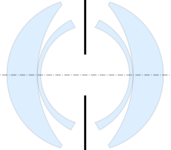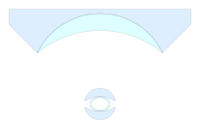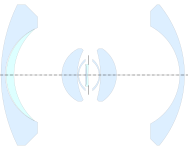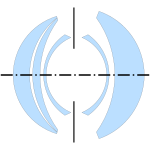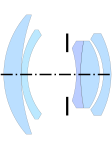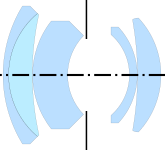Engineering:Topogon
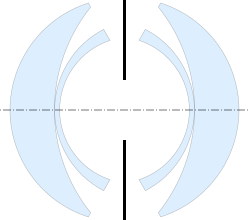 | |
| Introduced in | 1933 |
|---|---|
| Author | Robert Richter |
| Construction | 4 elements in 4 groups |
| Aperture | 6.3 |
Topogon is a wide field (originally 100 degrees field of view), symmetrical photographic lens patented by Robert Richter in 1933 for Carl Zeiss AG.[1] As there are four meniscus elements in four groups, deployed symmetrically around the central aperture, it is considered a double Gauss lens variant.
Design
According to Richter, the Topogon was developed from the Goerz Hypergon (1900),[2] one of the first super-wide-angle lenses.[3] Richter credits the mathematician Emil von Höegh, who had designed the Dagor anastigmat (1892), with designing the Hypergon for Goerz. Although the Hypergon covered a wide angle of view (140°) and had good flatness of field and distortion characteristics, the maximum aperture was limited to f/22 to control longitudinal spherical aberration and chromatic aberration.[4]:54–55 A new computation of a "fast" Hypergon was made by limiting the angle of view to 90°, which allowed an increased maximum aperture of f/6.3.[3]
The Topogon was derived from the "fast" Hypergon by adding a second, symmetric set of strongly curved meniscus elements inside the larger spherical elements to correct longitudinal spherical aberration.[3] The initial design patented by Richter was for a f=66mm f/6.3 lens covering 100°, although the patent also contains two other refinements to the basic design, including one that used parallel elements to minimize vignetting.[1] As the name suggests, the Topogon was intended to be used for topographical surveys and photogrammetry.[5]
The Topogon was later developed into the Pleon fisheye lens (1938)[6] and Pleogon lens by Richter and Friedrich Koch in 1956.[7] The Pleon was used for aerial surveillance during World War II, and was equipped with a large negative meniscus cemented group ahead of the Topogon core as an early example of an inverted telephoto design; a special projector was required to display an undistorted image.[8] The Pleogon, used for photogrammetry, used a cemented achromatic lens just ahead of the central stop and added two meniscus groups on either side to maintain lens symmetry.[3]
Topogon lenses have been produced with maximum apertures ranging from f/3.5 to f/15 in various focal lengths.[5]
- Hypergon, Topogon, and Zeiss development
Zeiss Topogon by Richter (1933), from US 2,031,792[1]
Zeiss Pleon by Richter (1938), from US 2,247,068[6]
Zeiss Pleogon by Richter & Koch (1956), from DE 1,097,710[7]
Influence
Goerz was merged into the Zeiss Ikon company in 1926.[9] An independent branch of Goerz in America, which had been established in 1895, licensed the Topogon design to Bausch & Lomb, who produced it as the Metrogon for the United States, citing the same US patent as the Topogon. The Metrogon was introduced in the early 1940s at the same cost "as a light automobile", limiting its market to aerial surveillance cameras for the United States Army Air Corps.[10] A later patent by Wilbur B. Rayton, assigned to Bausch & Lomb in 1943, separated one of the outer positive meniscus lenses into two air-spaced positive menisci,[11] similar to an earlier patent issued in 1938 to Hasselkus & Richmond.[12]
Although the main market for the Topogon similarly was aerial photography and mapping for military and government applications, a consumer version was produced for the pre-war Zeiss Ikon Contax 35mm rangefinder cameras and produced in small numbers as the Topogon 2.5 cm f/4. Lenses using similar designs also were produced by Canon (25mm f/3.5, 1956),[13][14] KMZ (Oриoн-15/Orion-15 28mm f/6, 1964),[15] and Nikon (W-NIKKOR·C 2.5cm f/4, 1954)[16] for their rangefinder systems after World War II.[5] In addition, Mamiya released a lens with a similar design for the Mamiya Press camera system, the Mamiya–Sekor 65mm f/6.3.[5][17][18]
Hybrid designs
The front meniscus elements of the Topogon were paired with the rear half of a double Gauss by Albrecht Tronnier and released as the Voigtlander Ultragon, a wide angle lens for large format cameras.[19]:16–17
As the opposite hybrid asymmetric design, the rear meniscus elements of the Topogon, forming a Gauss lens, have been paired with the front elements from a Planar-type double Gauss lens, resulting in the designs shared by the Schneider Kreuznach Xenotar (1952)[20][21] and Zeiss Planar (1953)[22] & Biometar (1959).[23] The Xenotar and Planar were fitted to Rolleiflex TLR cameras as an upgrade over Tessar/Xenar types,[24] and the Biometar was the standard lens for the Pentacon Six (aka Praktisix / Exakta 66) SLRs, with a Xenotar available for the same camera.[25]
- Topogon derivatives
Topogon derivative by Hasselkus & Richmond (1936), from US 2,116,264[12]
Voigtländer Ultragon by Tronnier (1951), from US 2,670,659[26]
Zeiss Planar by Lange (1953), from US 2,724,994[22]
Zeiss Biometar by Zöllner (1959), from US 2,968,221[23]
References
- ↑ 1.0 1.1 1.2 Robert Richter, "Anastigmatic objective for photography and projection", US patent Patent 2031792, issued February 25, 1936
- ↑ 2.0 2.1 Carl Paul Goerz, "Astigmatically-corrected wide-angle objective", US patent Patent 706650, issued 12 August 1902
- ↑ 3.0 3.1 3.2 3.3 Richter, Robert (December 1956). "Development and Perfection of the Topogon Lens". Photogrammetric Engineering & Remote Sensing XXII (5): 868–874. https://www.asprs.org/wp-content/uploads/pers/1956journal/dec/1956_dec_868-874.pdf. Retrieved 9 November 2018.
- ↑ Template:Kingslake-lens-history
- ↑ 5.0 5.1 5.2 5.3 Cavina, Marco. "Hypergon - Topogon - Russar - Biogon - Aviogon - Hologon: La storia definitiva dei super-grandangolari simmetrici". http://www.marcocavina.com/articoli_fotografici/Hypergon_Topogon_Biogon_Hologon/00_pag.htm. Retrieved 8 November 2018.
- ↑ 6.0 6.1 "Anastigmatic photographic objective" US patent Patent 2247068, published June 24, 1941
- ↑ 7.0 7.1 & Friedrich Koch"Anastigmatisches lens" DE patent Patent 1097710
- ↑ Gardner, Irvine C.; Washer, Francis E. (February 1948). Lenses of Extremely Wide Angle for Airplane Mapping (Report). National Bureau of Standards, U.S. Department of Commerce. https://archive.org/details/jresv40n2p93/. Retrieved 24 March 2023.
- ↑ "Zeiss Ikon". https://www.pacificrimcamera.com/pp/zeissikon.htm.
- ↑ "Lens Doubles Area Covered by Aerial Camera, Saving Time in Air Corps Mapping". Popular Science (Popular Science Publishing Co., Inc.) 139 (3): 104. September 1941. https://books.google.com/books?id=9iYDAAAAMBAJ&pg=PA104.
- ↑ 11.0 11.1 Wilbur B. Rayton, "Photographic objective", US patent Patent 2325275A, issued July 27, 1943
- ↑ 12.0 12.1 John William Hasselkus & George Arthur Richmond, "Objective suitable for photographic purposes", US patent Patent 2116264A, issued May 3, 1938
- ↑ "CANON 25mm f/3.5". Canon Inc.. December 1956. https://global.canon/en/c-museum/product/s35.html. "A super wide angle lens with a diagonal angle of view 82°, developed based on Topogon (manufactured by Carl Zeiss, Germany. Angle of view: 100°. f/6.3). This lens has a unique optical system: a spherical lens element with a very high refraction index is used as the first lens element and a special optical glass lens element with the infinite radius of curvature is used as the rearmost lens element."
- ↑ "Canon Rangefinder 25mm lenses". https://www.canonrangefinder.org/Canon_25mm.htm.
- ↑ "Orion-15". http://www.sovietcams.com/index71c4.html.
- ↑ Sato, Haruo. "W-NIKKOR·C 2.5cm F4 (No.29)". Nikon Imaging. https://imaging.nikon.com/imaging/information/story/0029/index.html. "The entire world gradually became caught in the vortex of World War II. Under the circumstances, the Topogon lens was highly valued for its low distortion and curvature of field, and was then saddled with heavy responsibility as an optical system for aerial photography and cartography. Optical designers in many countries began to devote all their energies to develop a distortion-free, wide-angle lens of the Topogon type. In those days, the lack of an accurate map of enemy territories meant certain defeat. At that time, Nippon Kogaku was also reportedly studying vigorously the Topogon-type lenses. After peace returned to the world, the efforts of the pioneers bore fruit in the world of the artistic culture of photography. Their efforts were incorporated also in the Nikkor 2.5cm f/4."
- ↑ Panagopoulos, Theo (July 4, 2021). "Mamiya Press Super 23 — Frustratingly Superb". https://photothinking.com/2021-07-03-mamiya-press-super-23-frustratingly-good/.
- ↑ "Mamiya Press Super 23 / Universal Press: Compact multi-format cameras, lenses, and accessories". Bell & Howell / Mamiya Company. February 1976. https://www.pacificrimcamera.com/rl/02625/02625.pdf.
- ↑ Cröll, Arne (August 10, 2020). "Voigtländer Large Format Lenses from 1949-1972". https://www.arnecroell.com/voigtlaender.pdf.
- ↑ 20.0 20.1 Günther Klemt & Karl Heinrich Macher, "Optical system with four air-spaced members", US patent Patent 2683398, issued July 13, 1954
- ↑ Cavina, Marco. "Carl Zeiss Planar 80mm 1:2,8 per Rolleiflex TLR". https://www.nocsensei.com/camera/tecnica/marco-cavina/marcocavina/carl-zeiss-planar-80mm-128-per-rolleiflex-tlr/.
- ↑ 22.0 22.1 Günther Lange, "Photographic objective comprising four meniscus shaped air spaced components", US patent Patent 2724994, issued November 29, 1955
- ↑ 23.0 23.1 Harry Zollner, "Photographic five-element lenses of the modified Gauss type", US patent Patent 2968221A, issued January 17, 1961
- ↑ Allen, Colton (January 25, 2018). "Rolleiflex buying guide". https://www.filmshooterscollective.com/analog-film-photography-blog/rolleiflex-buying-guide-1-11. "In general though, a Planar or Xenotar should perform better than a Tessar or Xenar, especially wide open. My experience with my 2.8C Planar and 3.5F Xenotar is that the 3.5 Xenotar is a sharper lens while the 2.8 Planar has better character. I strongly suspect that has more to do with the difference of the 3.5 vs 2.8 than Planar vs Xenotar."
- ↑ Horton, Zach. "The Pentacon 6 Lens Hit List". http://www.zachhorton.com/academia/the-pentacon-6-lens-hit-list/. "This [Xenotar 80mm f/2.8 MF] was Schneider's entry as the best 6×6 lens in the world. It measures up. It blows away the Zeiss 80mm Planar f/2.8 made for the Hasselblad system, and that is considered the best of the best. It is sharp wide open, has mechanics to dream of (like all of the Exakta 66 lenses), and has a special character to its rendering that makes it more pleasing than any other medium format 80mm lens I’ve ever seen."
- ↑ Albrecht W. Tronnier, "Modified gauss-type photographic objective formed of four components arranged in two groups", US patent Patent 2670659A, published March 3, 1954
External links
 |

